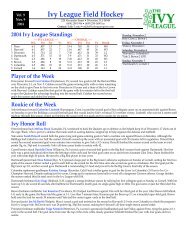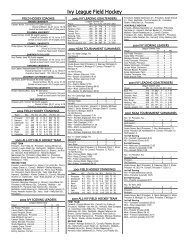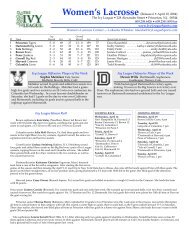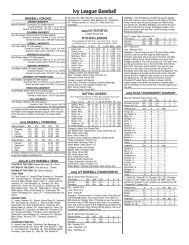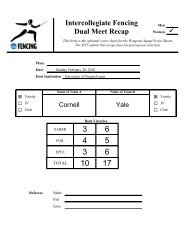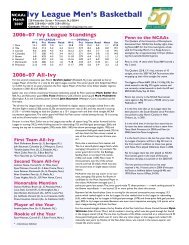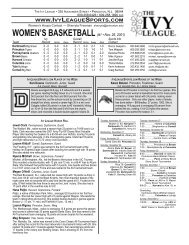Ivy League Sports
Ivy League Sports
Ivy League Sports
You also want an ePaper? Increase the reach of your titles
YUMPU automatically turns print PDFs into web optimized ePapers that Google loves.
The Council of <strong>Ivy</strong> Group PresidentsOctober, 1933 Stanley Woodward of the New York Herald Tribune first uses the phrase "<strong>Ivy</strong> colleges" in print todescribe the eight current <strong>Ivy</strong> schools (plus Army). On Feb. 8, 1935, AP <strong>Sports</strong> editor Alan Gould first uses theexact term "<strong>Ivy</strong> <strong>League</strong>". [From Mark Bernstein, Football: The <strong>Ivy</strong> <strong>League</strong> Origins of an American Obsession,University of Pennsylvania, 2001]1945 The first "<strong>Ivy</strong> Group Agreement" is signed, applying only to football. It affirms the observance of commonpractices in academic standards and eligibility requirements and the administration of need-based financial aid,with no athletic scholarships. The agreement creates the Presidents Policy Committee, including the eightPresidents; the Coordination and Eligibility Committee, made up of one senior non-athletic administrator from eachschool; and the committee on Administration, comprised of the eight athletic directors.February, 1954 The <strong>Ivy</strong> Presidents extend the <strong>Ivy</strong> Group Agreement to all intercollegiate sports. Their statementalso focuses on presidential governance of the league, the importance of intra-<strong>League</strong> competition, and a desirethat recruited athletes be academically "representative" of each institution’s overall student body. Although this isthe <strong>League</strong>’s official founding date, the first year of competition is 1956-57.December, 1969 Clayton Chapman, Assistant Athletic Director at Cornell, becomes Executive Secretary of theCouncil, providing its first staff assistance.March, 1971 The <strong>Ivy</strong> <strong>League</strong> becomes the last conference in the country to endorse the national change to freshmaneligibility on varsity teams. Although the <strong>Ivy</strong> Presidents do not permit the change in all team sports, by 1980the change is complete in all team sports except in football and men’s rowing.December, 1971 With women now enrolled as undergraduates at all eight <strong>Ivy</strong> institutions, the Presidents unanimouslyapprove the proposal of the Coordination and Administration Committees that "The <strong>Ivy</strong> Group rules of eligibilityshall not be construed to discriminate on grounds of sex."July, 1973 The Presidents agree to appoint a full-time coordinator for the <strong>Ivy</strong> Group, and in December RicardoMestres, a Vice President at Princeton, attends his first Presidents meeting as the <strong>Ivy</strong> Group’s permanentExecutive Director.May, 1974 The <strong>Ivy</strong> Group officially begins <strong>League</strong> championships in women’s sports, as the Radcliffe-Harvardwomen crew wins the first official women’s <strong>Ivy</strong> championship.March, 1976 James Litvack, a Princeton faculty member, becomes the second Executive Director. A joint committeeis formed to make specific recommendations for applying rules equitably to both men and women, and to considerrules for the number of contests, length of seasons, etc., in women’s sports.February, 1977 The <strong>Ivy</strong> Presidents approve a 10th game for football, previously limited to nine games.August, 1977 The <strong>Ivy</strong> Presidents adopt the name Council of <strong>Ivy</strong> Group Presidents, and the Coordination andEligibility Committee becomes the Policy Committee.June, 1979 On the 25th anniversary of the 1954 Agreement, the Council of Presidents issues a 10-point Statementof Principles, reaffirming basic goals with regard to admissions, financial aid, and the role of athletics in the undergraduateeducational experience.May, 1980 On recommendations of the Athletic Directors and Policy Committee, the Council of Presidents unanimouslyadopts the "Parry-Ryan" report, a comprehensive approach to assuring that the scope of scheduling, competitionand practice opportunities will be consistent with athletes’ academic priorities. This basic structure remainsin effect today.Fall/Winter, 1981 Marking the 25th anniversary of the first <strong>Ivy</strong> season, sportswriters covering the <strong>League</strong> select alltimeSilver Anniversary Football and Men’s Basketball teams.December, 1981 A special NCAA convention creates a "I-AA" football division and <strong>Ivy</strong> <strong>League</strong> members begin playin that division the following September.September, 1984 Jeffrey Orleans, a Yale graduate and lawyer and author of the federal Title IX regulation, isappointed the third Executive Director of the Council of <strong>Ivy</strong> Group Presidents, and is authorized to develop a central"<strong>Ivy</strong> Office" for the <strong>League</strong>.June, 1985 The Council adopts a structure to set minimum academic qualifications for all recruited athletes and toregulate the number and qualifications of recruited athletes in football and men's basketball and ice hockey specifically.July, 1986 Constance Huston Hurlbut becomes the <strong>League</strong>’s first Assistant Director, assuming responsibility for <strong>Ivy</strong><strong>League</strong> sports publicity from the institutional sports information offices. In 1993, Hurlbut becomes ExecutiveDirector of the Patriot <strong>League</strong>.June, 1989 The Council approves a third professional position, dividing the functions of rules compliance andsports information; Charles Yrigoyen III becomes Assistant Director for public information.June and December, 1991 Coincident with reducing the permitted number of recruited football players, theCouncil agrees to freshman eligibility in football and to 12 sessions of spring practice for football rather than onespring "media day".April, 1993 The <strong>Ivy</strong> <strong>League</strong> receives its first automatic bid to the NCAA Division I Women’s Basketball championship,for 1994. In the next few years the <strong>Ivy</strong> <strong>League</strong> will become the only conference to attain automatic bids inevery women’s sport.July, 1993 Carolyn Campbell McGovern succeeds Connie Hurlbut as Senior Associate Director. While extendingand formalizing <strong>Ivy</strong> rules compliance activities, and assisting the eight <strong>Ivy</strong> institutions through the first NCAA "certification"reviews, she also will chair both the Olympic <strong>Sports</strong> and Women’s Ice Hockey Committees of the NCAA.June, 1994 The Council of Presidents approves the appointment of a Senior Women’s Athletic Administrator to thePolicy Committee, a position complementing the long-standing representation of a Director of Athletics.August, 1996 Associate Director Chuck Yrigoyen oversees the inauguaration of the <strong>Ivy</strong> <strong>League</strong> website(www.<strong>Ivy</strong><strong>League</strong><strong>Sports</strong>.com), and begins the <strong>League</strong>’s transition to electronically-focused sports information.May, 1998-April, 1999 The <strong>Ivy</strong> <strong>League</strong> holds a year-long celebration of the 25th Anniversary of <strong>Ivy</strong> <strong>League</strong>Women’s Championships, including events at each campus, a traveling photo-history mural, timeline exhibit, selectionof the women’s Silver Anniversary Team in all sports and a two-day symposium in April 1999, in New York Citywith 300 alumnae and other participants. The <strong>League</strong>’s Silver Anniversary is remembered in print with theNovember, 1999 publication of Silver Era, Golden Moments, an authoritative 200-page narrative and photographichistory.July, 2000 The Council approves a fourth professional position to provide for the first time a focus on championships,officiating, scheduling, and other aspects of sport administration. Brett A. Hoover becomes the newAssistant Director for Public Information, focusing on web-based communication with the media and all <strong>Ivy</strong> constituencies.2001-02 In the first year of a reconstructed <strong>League</strong> website, <strong>Ivy</strong><strong>League</strong><strong>Sports</strong>.com draws nearly a million visitorsand nearly 12 million page views.June, 2002 & June, 2003 The Council amends its 1985 structure for monitoring the academic qualifications ofrecruited athletes by increasing its minimum qualifications, regulating the number and qualifications of the athleteswho are recruited at each school, and reducing the permitted number of recruited football players. The Council alsoassures that athletes will have additional time for academic priorities and other personal interests by adding 49days without practice or other athletic obliations, for all athletes, to the non-athletic time provided by <strong>Ivy</strong> rules since1980.The designation “<strong>Ivy</strong> <strong>League</strong>,” premature of any formal agreement, was adoptedby the press as a foreshadowing of an eastern football league which, at the time,was big news to everyone except the athletic directors involved.For years, the <strong>Ivy</strong> members already had been allied in leagues in basketball, icehockey, baseball and swimming. Further common competition was found in theHeptagonal Games Association, which included Army and Navy, in the sports ofbaseball, track and field, and swimming. Through these other scheduling arrangements,the <strong>Ivy</strong> athletic directors were used to dealing with each other in matters ofadministration or the exchange of calculated confidences.As a result of these dealings, and through extensive presidential meetings anddiscussions, the first “<strong>Ivy</strong> Group Agreement” -- addressing only football -- wassigned in 1945. While the 1945 statement did not address any scheduling issues, itdid affirm the observance at the eight institutions of common practices in academicstandards, eligibility requirements, and the administration of financial aid for athletes.These tenets are what still bind the Ivies together today and all continue to bebased on the desire to secure competition with others having like philosophies. Theathletic directors, at the direction of the presidents, were then more formally organizedas a committee for cooperative endeavor in the details of athletic administrationand a dean from each school was appointed to a committee to exchange informationon eligibility and to act for the presidents in cooperation with the athletic directors.In February 1954, what is more commonly accepted as the founding date forthe <strong>Ivy</strong> <strong>League</strong>, the <strong>Ivy</strong> Group Agreement was reissued to extend its philosophicaljurisdiction to all sports and to foster, insofar as possible, intra-group competition. Inlayman’s terms, that meant a complete round-robin schedule in football, beginningwith the 1956 season. Such an agreement -- assuring seven spots on an eight-toten-game schedule to <strong>Ivy</strong> opponents -- required numerous concessions from eachinstitution and marked a high point in intercollegiate cooperation.The basic intent of the original <strong>Ivy</strong> agreement was to improve and foster intercollegiateathletics while keeping the emphasis on such competition in harmony withthe educational purpose of the institutions. While football is where it started, the <strong>Ivy</strong><strong>League</strong> today is nationally recognized for its level of success -- absent of athleticscholarships -- while rigorously maintaining its self-imposed high academic standards.The <strong>Ivy</strong> <strong>League</strong> has demonstrated a rare willingness and ability, given thecurrent national pressures on intercollegiate success, to abide by these rules andstill compete successfully in Division I athletics.The <strong>Ivy</strong> <strong>League</strong> crowns champions in 33 sports and continues to sponsor intercollegiateprograms of national prominence for women and men. Lacrosse, icehockey, fencing, soccer, rowing and squash are some of the sports in which theIvies have been synonymous with national excellence during the <strong>League</strong>’s recenthistory. On the average, <strong>Ivy</strong> members boast of 35 varsity teams per campus, wellabove the national norm.Last season was yet another outstanding year for the <strong>Ivy</strong> <strong>League</strong>. In fact, it wassuch a great year that it concluded with the <strong>League</strong> finishing sixth in the SearsDirectors Cup standings, behind only a handful of the nation's elite conferences andahead of the perennial power Big East Conference. The Princeton women'slacrosse team won the NCAA national title for the second straight year. Harvardwomen’s rowing took the national championship while the Princeton Tigers pickedup their fifth straight title in the women’s lightweight division. Harvard’s men's heavyweightand lightweight eights each went on to open water victories in their respectivegrand finals of the IRA National Championships.In addition to the team national champions, the eight <strong>Ivy</strong> schools produced severalindividual national champions as well as more than 100 All-Americans and fourteenAcademic All-Americans.Highlights included Brian Chaput and Sam Burley of Penn capping a stellar seasonby winning national titles in their events during the outdoor track championships.Chaput tossed the javelin 258-2 for a new <strong>Ivy</strong> <strong>League</strong> record, while Burleytook home the title in the 800 meters by just one hundredth of a second. Cornellwrestler Travis Lee brought home a national title in the 125 pound class, goingundefeated on the season, while Yasser El-Halaby of Princeton became a nationalsquash champion. In addition to national champions, more than 50 individual athletesplaced in the top 10 or reached the quarterfinals of the national championshipin their sport.More than 75 <strong>Ivy</strong> <strong>League</strong> athletes have competed at the last Summer (Sydney,2000) and Winter (Salt Lake City, 2002) Olympics and a remarkable number --twenty-four -- have brought home medals.Cheering on Brown’s soccer teams; the precision and artistry of Columbia’snational powerhouse fencers; the speed and stamina of Cornell’s cross country runners;the 17 league football titles won by Dartmouth; a workout on the Charles Riverfor Harvard’s crews; basketball games at Penn’s storied Palestra; Princeton’slacrosse teams; the beauty and challenge of the Yale Golf Club. These are justsome of the elements that have helped the Ivies foster a wonderful, rare spirit ofcompetition, excellence, and camaraderie for athletes, spectators, and alumni.Located on the campus of Princeton University, the <strong>Ivy</strong> <strong>League</strong> (still known officiallyas the Council of <strong>Ivy</strong> Group Presidents) continues to grow under the leadershipand direction of Executive Director Jeffrey H. Orleans. Since taking the post in1984, Orleans has become a respected voice on the national scene of intercollegiateathletics.(Editor’s Note: Portions of this text appeared in the first <strong>Ivy</strong> <strong>League</strong> FootballGuide in 1954 and were written by William H. McCarter, Director of Athletics atDartmouth College from 1937-54.)



